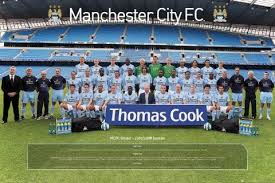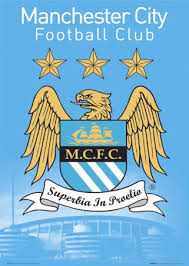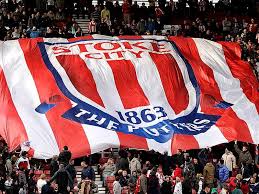
 |  |  |

English Premier League
England
The Barclays English Premier League (EPL), considered as the best in the world.
Manchester City vs Stoke City
Official name Manchester City FC
City Manchester
Founded 1880
Club colors Light-Blue/ White / White
vs.
0 - 0
Stoke City
Official name Stoke City FC
City Stoke-on-Trent
Founded 1868
Club colors Red-White / White / White
Match scheduled:
Date: 26-12-2009
Time:15:00 until 17:00
Week 19 / Round 19 :: Barclays Premier League 2009/2010


Stoke City F.C., considered to be the second-oldest English football league club, formed in 1863, under the name Stoke Ramblers, when pupils of Charterhouse School formed a football club while apprentices at the North Staffordshire Railway works in Stoke-on-Trent.[1] The club's first documented match was five years later, in October 1868, against an EW May XV at the Victoria Cricket Club ground. Henry Almond, the club's founder, was also captain, and scored the club's first ever goal. During this period they played at the Victoria Cricket Ground; however, they switched to a nearby ground at Sweetings Field in 1875 to cope with rising attendances.[1]

In 1878, the club merged with Stoke Victoria Cricket Club, and became Stoke Football Club.[1] They moved from their previous ground, Sweetings Field, to the Athletic Club ground, which soon became known as the Victoria Ground.[2] It was around this time that the club adopted their traditional red-and-white striped kit. In August 1885, the club turned professional.[1]
Stoke was one of the twelve founding members of The Football League when it was introduced in 1888.[3] The club struggled in their first two seasons, 1888-89 and 1889-90, finishing bottom on both occasions.[4] In 1914, the First World War meant the league was suspended for four years, until it eventually recommenced in August 1919. During this wartime period, Stoke entered the Lancashire Primary and Secondary leagues.[5]
Stoke won promotion to the Premier League after a goalless draw with Leicester City on the last day of the 2007–08 season, putting them in 2nd place of The Championship, thus earning automatic promotion. The promotion earned Stoke £35 million for the 2008–09 season, and a minimum of £60 million over the space of three seasons[47].
Despite poor-runs in both the FA and Carling Cups, the club exceeded expectations in terms of 2008–09 League performance. A defeat to Bolton Wanderers[48] on the opening day of the season did not bode well, with bookmaker Paddy Power paying out on Stoke to be relegated[49], but fortunes quickly changed. In Stoke’s first game of the season at the Britannia Stadium, the team managed to pick up all three points against Aston Villa, following a 3-2 win[50], and notably, on 20 September, held Liverpool to a 0-0 draw at Anfield[51]. Wins also came against Tottenham Hotspur[52], Arsenal[53], Sunderland[54] and West Bromwich Albion[55], all before the end of November, however on 15 November, league-champions Manchester United gave Stoke their largest defeat of the season, with a full-time score of 5-0[56].
In the following months, Stoke’s quest for silverware came to an end after being knocked out of the Carling Cup by Derby County in the quarter-finals[57], and the FA Cup by Hartlepool United in the third-round[58]. The New Year brought further points in the league though, with draws against Portsmouth[59] and Aston Villa[60], and a 2-0 win against Bolton Wanderers[61]. From the 21st March, Stoke scored points in four consecutive games, only dropping points to Newcastle United[62] in this time. After a 2-1 win at Hull City[63], Stoke confirmed their place in the Premier League 2009–10, and reached a league high of 11th place after defeating Wigan Athletic, 2-0. A defeat to Arsenal away meant that the Potters finished 12th in their return to the top flight.[64].
After relegation, the club underwent off-the-field upheaval, with new chairman David Bernstein introducing greater fiscal discipline.[20] City were promoted at the first attempt, achieved in dramatic fashion in a play-off against Gillingham. A second successive promotion saw City return to the top division, but this proved to have been a step too far for the recovering club, and in 2001 City were relegated once more. Kevin Keegan arrived as the new manager in the close season, bringing an immediate return to the top division as the club won the 2001–02 Division One championship, breaking club records for the number of points gained and goals scored in a season in the process.[21]
The 2002–03 season was the last at Maine Road, and included a 3–1 derby victory over rivals Manchester United, ending a run of 13 years without a derby win.[22] City also qualified for European competition for the first time in 25 years. In the 2003 close season the club moved to the new City of Manchester Stadium. The first four seasons at the stadium all resulted in mid-table finishes. Former England manager Sven-Göran Eriksson became the club's first manager from overseas when appointed in 2007.[23] After a bright start performances faded in the second half of the season, and Eriksson was sacked in June 2008.[24] Eriksson was replaced by Mark Hughes two days later on 4 June 2008.[25]
In August 2008, the club was purchased by Abu Dhabi United Group. The takeover was immediately followed by a flurry of bids for high profile players; the club broke the British transfer record by signing Brazilian international Robinho from Real Madrid for £32.5 million.[26] City finished tenth, and also reached the quarter-finals of the UEFA Cup. During the summer of 2009 the club took transfer spending to an unprecedented level, with an outlay of over £100 million on players Gareth Barry, Roque Santa Cruz, Kolo Touré, Emmanuel Adebayor, Carlos Tévez and Joleon Lescott.[27]
Good performances early in the 2009-10 season set up expectations of a top four finish, but a string of draws and a couple of poor away performances saw City slip to eighth position in the Premier League. Although they had reached the semi-finals of the Carling Cup, on December 19, 2009, it was announced that Mark Hughes had been dismissed as manager, and that Roberto Mancini would take over as manager.[28]
Club crest and colours
Manchester City's home colours are sky blue and white. Traditional away kit colours have been either maroon or (from the 1960s) red and black; however, in recent years several different colours have been used. The origins of the club's home colours are unclear, but there is evidence that the club has worn blue since 1892 or earlier. A booklet entitled Famous Football Clubs – Manchester City published in the 1940s indicates that West Gorton (St. Marks) originally played in scarlet and black, and reports dating from 1884 describe the team wearing black jerseys bearing a white cross, showing the club's origins as a church side.[29] The red and black away colours come from former assistant manager Malcolm Allison, who believed that adopting the colours of AC Milan would inspire City to glory.[30]
The current club crest was adopted in 1997, a result of the previous crest being ineligible for registration as a trademark. The badge is based on the arms of the city of Manchester, and consists of a shield in front of a golden eagle. The shield features a ship on its upper half representing the Manchester Ship Canal, and three diagonal stripes in the lower half, for the city's three rivers. The bottom of the badge bears the motto Superbia in Proelia, which translates as Pride in Battle in Latin. Above the eagle and shield are three stars, which are purely decorative.[31]

Manchester City's current stadium is the City of Manchester Stadium, also known as "Eastlands", a 47,726 capacity stadium situated in East Manchester, leased from Manchester City Council after the 2002 Commonwealth Games. The stadium has been City's home since the end of the 2002–03 season, when the club moved from Maine Road.[57]
Before moving to the stadium, Manchester City spent in excess of £30 million to convert it to football use. The field of play was lowered by several metres, adding an additional tier of seating around the entire pitch. A new North Stand was also built.[58] The inaugural match at the new stadium was a 2–1 win over FC Barcelona in a friendly match.[59]
Manchester City have used several grounds during their history: after playing home matches at five different stadia between 1880 and 1887, the club settled at Hyde Road, its home for 36 years.[60] After a fire destroyed the Main Stand in 1920, the club started to seek a new site and moved to the 84-000 capacity Maine Road three years later. Maine Road, nicknamed the "Wembley of the North" by its designers, hosted the largest-ever crowd at an English club ground when 84,569 attended an FA Cup tie against Stoke City on 3 March 1934.[61] Though Maine Road was redeveloped several times over its 80-year lifespan, by 1995 its capacity was restricted to 32,000, prompting the search for a new ground which culminated in the move to the City of Manchester Stadium in 2003.
 |  |  |









